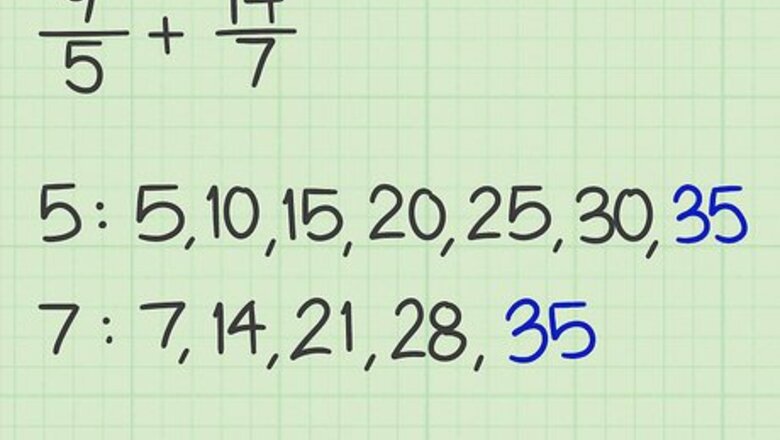
views
Working with Improper Fractions

Find the least common multiple (LCM) for the denominators. Because you have to make the denominators the same before you add the fractions, find a common multiple that they share. Then choose the lowest one. For example, for 9/5 + 14/7, the multiples of 5 are 5, 10, 15, 20, 25, 30, and 35 while the multiples of 7 are 7, 14, 21, 28, and 35. 35 is the least common multiple.
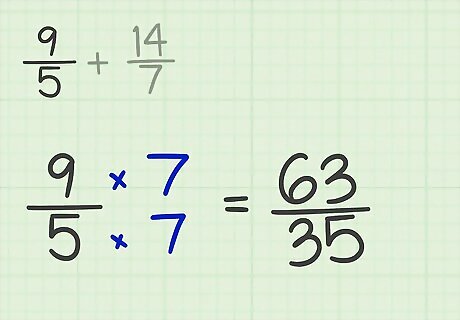
Multiply the numerator and denominator to get like denominators. You'll need to multiply the entire fraction to make the denominator become the least common multiple. For example, multiply 9/5 by 7 to get a denominator of 35. You should also multiply the numerator by 7, so the fraction becomes 63/35.
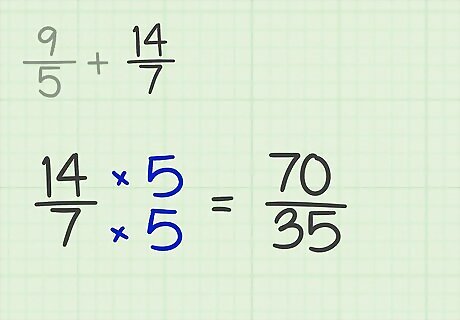
Turn the other fractions into equivalent fractions. Remember that when you adjust 1 fraction in your problem, you also have to adjust the other fractions so they're equivalent. For example, if you've adjusted 9/5 to 63/35, multiply 14/7 by 5 to get 70/35. Your original problem 9/5 + 14/7 will turn into 63/35 + 70/35.

Add the numerators but leave the denominators the same - these don't change. Once all of the denominators in your problem are the same, add the numerators. Put the answer over the denominator. For example, 63 + 70 = 133. Place it over the denominator to get 133/35.

Simplify or reduce the answer if necessary. If your answer is improper, turn the fraction into a mixed number. To do this, divide the numerator by the denominator so you get a whole number. Then see how many parts are left and place this number over the denominator. Reduce the fraction if it can be simplified further. For example, 133/35 can be simplified to 3 28/35. The fraction can be reduced to 4/5 so the finished answer is 3 4/5. EXPERT TIP Joseph Meyer Joseph Meyer Math Teacher Joseph Meyer is a High School Math Teacher based in Pittsburgh, Pennsylvania. He is an educator at City Charter High School, where he has been teaching for over 7 years. Joseph is also the founder of Sandbox Math, an online learning community dedicated to helping students succeed in Algebra. His site is set apart by its focus on fostering genuine comprehension through step-by-step understanding (instead of just getting the correct final answer), enabling learners to identify and overcome misunderstandings and confidently take on any test they face. He received his MA in Physics from Case Western Reserve University and his BA in Physics from Baldwin Wallace University. Joseph Meyer Joseph Meyer Math Teacher Simplifying a fraction just changes the way the fraction is written. To simplify a fraction, you can cancel out the greatest common factor from the numerator and denominator or convert an improper fraction to a mixed number. This doesn't change the inherent value of the fraction.
Adding Mixed Numbers
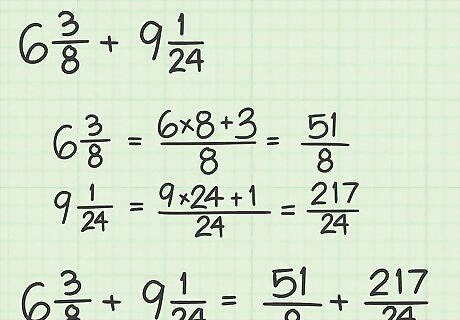
Turn the mixed numbers into improper fractions. If you have fractions with whole numbers, changing them into improper fractions will make it easier to add. The numerators of your improper fractions will be larger than their denominators. For example, 6 3/8 + 9 1/24 will turn into 51/8 + 217/24.

Look for the lowest common denominator if necessary. If the denominators are different, you'll need to write down the multiples of each denominator so you can find 1 that they have in common. For example, for the problem 51/8 + 217/24, list the multiples of 8 and 24 to find 24. Because the multiples of 8 include 8, 16, 24, 32, and 48 and the multiples of 24 include 24, 48, and 72, 24 is the lowest common multiple.

Make the fraction equivalent if you need to change the denominators. The denominators should all become the lowest common multiple that you found. Multiply the whole fraction by a number to make the denominator the lowest common multiple. For example, to make the denominator for 51/8 become 24, multiply the whole fraction by 3. You should get 153/24.

Change all of the fractions in the problem to make them equivalent. If the other fractions in your equation have different denominators, you'll also have to multiply them so they have the same denominator. If the fraction already has that as the denominator, you don't need to adjust the fraction. For example, if you're working with 217/24, you won't need to adjust the fraction since it already has the same denominator.

Add the numerators but leave the denominator the same, these don't change. You can add the numerators once the denominators are the same or if there were the same from the start. Once you've added the numerators, put the answer over the denominator. Avoid adding the denominators. For example, 153/24 +217/24 = 370/24.
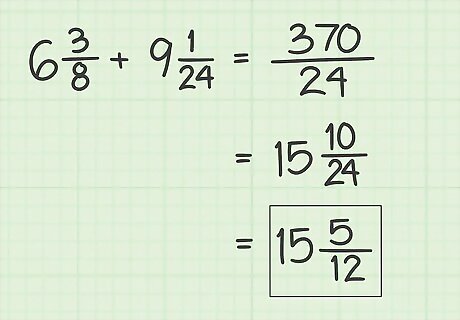
Simplify your answer. If your numerator of your answer is larger than the denominator, you'll have to divide it to get a whole number. To finish making a mixed number, write down how many parts you have leftover. This will make the numerator which you can put over the same denominator. Keep reducing the fraction down until it's in its simplest form. For example, 370/24 will become 15 10/24 because 24 goes into 370 15 times and has 10 parts of 24 left over. 10/24 can be further reduced to 5/12 for a finished answer of 15 5/12.


















Comments
0 comment